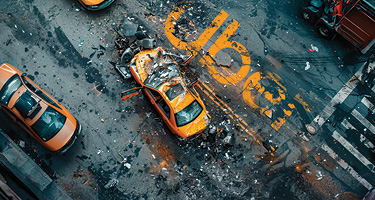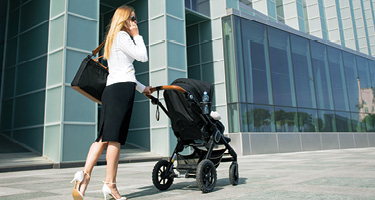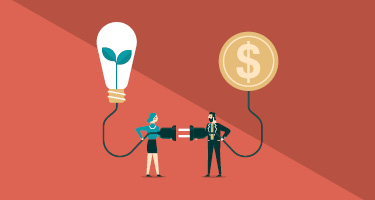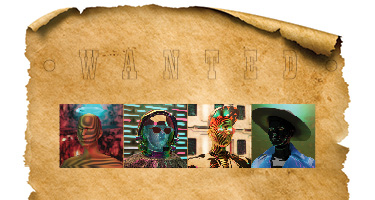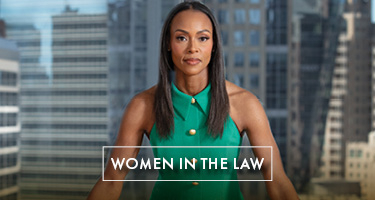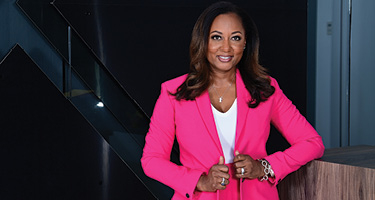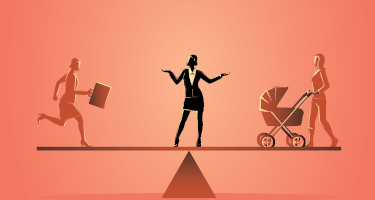Attorney Sarah R. London’s parents may not have been lawyers, but they raised her like one. From the time she could talk, the Illinois native maintains that her mother, a public schoolteacher, and her father, a small business owner and salesman, taught her to think like a lawyer and advocate for herself.
“My parents took my arguments about the tooth fairy undervaluing what was under my pillow seriously,” she recalled, laughing. “They allowed me to negotiate, and I think from early on, I developed tools to work with that righteous sense of justice that a kid believes they have. Anyone who knew me thought I would become a rabbi or a lawyer.”
This telling anecdote is one of many that laid the foundation for a lifetime of fighting for herself and others.
London spent the first 15 years of her legal career at Lieff Cabraser Heimann & Bernstein in San Francisco, building a track record of excellence representing classes of plaintiffs, leading its fertility practice, and representing clients harmed by vaping and tobacco companies, dangerous drugs and medical devices, and environmental disasters.
Recognized in Best Lawyers® for Mass Tort Litigtion / Class Actions – Plaintiffs since 2018, London’s recorded many career milestones, but her work as co-lead plaintiffs’ counsel in the JUUL Marketing and Sales Practices MDL [3:19-md-02913-WHO] stands out as one critical highlight.
In December 2022 and March 2023, as co-lead plaintiffs’ counsel, London secured landmark global settlements with vape company Juul Labs for reportedly $2 billion that resolved claims from harmed individuals, consumers, school districts, and tribal nations, a result that contributed to her being named the California Consumer Attorney of the Year by the Consumer Attorneys of California.
And it was during the years-long MDL against Juul Labs that she raised her growing family while also undergoing prophylactic surgeries to prevent breast cancer. The pressure of managing just one of these challenges is enough to overwhelm most people, but clearly someone unfazed by nature and biology would not be intimidated by squaring off against billion-dollar companies for years on end.
Some of London’s other courtroom highlights include: serving as co-lead counsel in the Uber Passenger Sexual Assault multidistrict litigation (MDL); trial counsel in nearly a dozen Florida Engle progeny tobacco cases; interim class counsel in the Pacific Fertility Center egg and embryo storage tank disaster litigation settlement; counsel in the Flint Water Cases; and as a member of the Plaintiffs’ Executive Committee in the Gilead HIV Drug Kidney & Bone Injuries Litigation.
In 2025, London joined the San Francisco law firm Girard Sharp as an equity partner to build its tort practice. She spoke with Best Lawyers to discuss the impact of her courtroom achievements and how she hopes to write the next chapter in the story of her career.
***
Best Lawyers: Like many lawyers, your early experiences as a community organizer helped set you on the path for legal advocacy. Tell us about those formative years prior to passing the bar.
London: After graduating from Northwestern University, I became an organizer. I was a political organizer for a union working with home care workers in Missouri, assisting to support their political program to help improve voter registration in their community.
And I became an organizer for Planned Parenthood of Kansas and Mid-Missouri during a time—and frankly, when wasn’t there a time?—when women’s rights and reproductive justice was in peril.
I really fell in love with the community organizing model for social change and standing up against injustice. Paul Wellstone was a huge influence on me and an entire generation of organizers. He was a beloved U.S. senator representing Minnesota and he was incredibly inspiring.
I loved it, and I thought I would spend my life organizing. And it was while I was organizing in Kansas, around reproductive justice and access to responsible sex education and safe and affordable health care for all women at all stages of their life that I kept running up against the language of the law, because I was lobbying.
I would have rallied my whole community around me that we would go to the Capitol, and we would be lobbying, and some state senator or another lobbyist who had a law degree would try and use that to put up blocks and obstacles for advancing justice. And I knew I had to learn that language if I was going to have a shot at achieving justice for the causes I felt strongly about.
You were clearly destined for a legal career and were accepted to the University of California’s Berkeley School of Law. Was plaintiffs’ law always the path after graduation and passing the bar?
Not immediately. I had the interest in working on cases on behalf of people, not companies.
But in the early 2000s there were not a lot of options for young lawyers or law students, because the on-campus interviewing process at the schools was largely Big Law firms or government employers.
But an advisor had a single printed page of maybe a dozen lawyers or firms who practiced plaintiffs’ law, and Elizabeth Cabraser’s name was on it. Lieff Cabraser’s mission aligned with my own, and I was really grateful I found them.
Elizabeth Cabraser and the Lieff Cabraser team clearly saw your potential, having tapped you to represent 4,000 individuals and their families as plaintiffs in Howard Engle et al vs RJ Reynolds et al, a class action lawsuit filed by hundreds of thousands of Floridians harmed by smoking.
Engle was a tremendous undertaking that cleared a path for the next several years as far as where my focus would be.
I tried 14 cases down in federal court in Florida. I learned a whole lot about what it takes to be effective and successful at trial, especially while collaborating alongside some well-known litigators.
But in addition to legal practice, I gained unique insight into the tobacco industry, including the science and the conduct and marketing strategies. This is where discovery and conversations with experts can be extraordinary experiences for a young lawyer, or any lawyer, involved in a trial of that magnitude.
We resolved our remaining cases globally for $100 million, and I had all this working knowledge about nicotine and understanding how tobacco products target youth. Shortly afterward, in summer 2019, was when the JUUL litigation began.
Sounds like perfect timing to put your new knowledge base to continued use.
Our firm was approached by a family of a young man who suffered a catastrophic stroke after using a Juul product and I dug in and looked at it really seriously. We filed one of the first personal injury cases—if not the first—against Juul Labs.
We had the confidence because all the hallmarks of the tobacco playbook from Engle were all there. I worked as part of a coalition of lawyers who had also been approached by youths and victims, including school districts, who had been affected by the vaping epidemic.
We built a coalition to advance these cases, alongside the consumer class actions, which quickly gained momentum as an MDL.
This marked your first time as a lead counsel in an MDL, which was even larger than Engle. You oversaw 65 law firms across more than 7,000 lawsuits alleging that the marketing, design, and distribution of the Juul e-cigarette caused a youth vaping epidemic.
JUUL was overseen by Judge William H. Orick III in the Northern District of California. I had the privilege of being co-lead counsel with Dena Sharp (Girard Sharp founder), along with Ellen Relkin (Weitz & Luxenberg) and Dean Kawamoto (Keller Rohrback), and it was just an incredible team with the entire Steering Committee.
This was a relatively unprecedented, streamlined plaintiff leadership structure managing cases on behalf of school districts, individuals with personal injuries, consumers in a consumer class case, cities and tribes.
What was the approach to a litigation of this size and scope?
Our theory at the beginning of the leadership structure organization was that more than 75% of the work to be done in this case would be common across the cases, such as discovery and motion practice. We had a steering committee of lawyers who had specialties and experiences in various types of practice.
We brought everybody together for this common purpose, and we trained one another. We employed a common strategy for the common good.
It sounds like a callback to your days as a community organizer.
Yes. It enabled us to really advance the litigation as a flock, which meant we could try really any case at any time. This allowed us to absorb any of the bumps in the road or any potential setbacks in any one aspect of the case.
We certainly faced a number of challenges, including the FDA making decisions about Juul in the middle of the litigation and the company announcing it may file for bankruptcy. This meant we’d have to pivot at any given time.
It was an extraordinary collaboration. All of these lawyers came together and were really open-minded, using the tools that they had, and we taught one another from our different various backgrounds about how to employ different tools to this multifaceted problem.
The claims were complex enough, but we also filed against Altria for its role (as former shareholder in Juul Labs), which included RICO claims that included other kinds of conspiracy claims and public nuisance claims.
We all really hit our stride and came together in March 2020.
Everyone remembers what was dominating the world at the time.
We had to pivot, really seamlessly litigate the case from Zoom. And obviously, now we look back and everybody does that. But it was my first leadership role in a multidistrict litigation and there was no established roadmap for that sort of virtual transition at the time.
But we trusted each other—and sure, kids were running around in the backgrounds, and the internet may have been spotty at times—but it worked.
The courts were very supportive of the litigations in front of it, it was amazing what the courts were able to do to keep the doors open for access to justice.
What was your family and personal life like during the JUUL litigation?
It was a lot happening at once. When we first started, my twins were 2 years old, and I had a 4-year-old son. It was a busy time, but as the expression goes: “When you want something done, give it to a busy mom.”
But during that time, I had also been diagnosed with the BRCA2 breast cancer gene. And in July 2020 I had the first of two major surgeries—double mastectomy—which required six weeks of bed rest afterward. That was all of course at the early days of the COVID-19 pandemic. I completed treatment later in 2021, with an oophorectomy and hysterectomy.
How did that impact the litigation?
It could have been disruptive, but it wasn’t a shock that I’d have those surgeries, and as we said earlier, we prepared well in advance.
Lieff Cabraser and my co-leads were incredibly supportive and ultimately, the surgeries and the bedrest had minimal impact. It was pretty seamless because I didn’t have to get on airplanes and didn’t have to travel—it wasn’t necessary for the work.
I still believe there’s no substitute for in-person strategy, time and sessions and for in-person court appearances on important matters, but it showed how that we can accomplish much of the day-to-day management and operations of running big, complex litigation.
The JUUL Labs litigation resulted in multibillion-dollar settlements over 2023 and 2024. There were obviously plenty of takeaways. What stands out most?
I kept the mentality that preparing for an actual trial—and not an out-of-court settlement—is the best way to strategize.
That unlocks the best work product and the creative problem-solving you can bring to a case. And it helps you avoid getting down rabbit holes and time suck and traps because you’re focusing on ultimately your key audience, which is the jury. This was all to the benefit of the clients, who in many cases had been through hell.
Let’s talk about working with Dena Sharp. In February 2025 you joined her firm, Girard Sharp, as an equity partner following 15-plus years at Lieff Cabraser. What led to that move?
I met Dena in 2018, while we were co-lead interim class counsel in a litigation involving a cryopreservation tank failure at Pacific Fertility Center in San Francisco, which resolved globally after Dena’s team obtained a $15 million trial verdict for five affected plaintiffs.
We forged and developed this great relationship, because it was not long after that we were appointed lead counsel in the JUUL case together, where we spent many years in the trenches together, and she’s just exactly who you want in the foxhole. She’s brilliant and very generous with her time and support.
Girard Sharp is a boutique firm, and she offered me the opportunity to build its tort practice. I deliberated on it a bit and spoke with Elizabeth Cabraser, and asked for her support, which she gave because she believes so firmly in advancing women in the law. She is an icon, and we’re still very close, and I continue to reach out to her for guidance. I’m really fortunate to have had such wonderful leaders and mentors throughout my career.
The women in your network are clearly supporting each other. On that topic, the American Bar Association dubbed 2016 to 2026 as the “Decade of the Female Lawyer,” in a recent report on national lawyer demographics. Best Law Firms US Legal Market Report 2025 found that diversity remains a significant struggle for firms across the industry.
How would you describe your experience in the past decade? Have you seen more women entering the profession and rising in the ranks?
Women made up more than half of my law school class in 2009. I do see women continuing to pursue legal education and legal careers in high numbers. I see the continued glass ceiling at the equity partner level and ownership level, as well as opportunities to serve as lead trial counsel.
But there has been some evolution.
It’s been exciting to watch a number of my colleagues go on to become equity partners or start their own firms, where they can serve their clients as lead trial counsel. And I think we’re seeing a real momentum in that direction. And I think that’s all for the betterment of the legal profession, because when women are at the table in numbers that reflect their presence within the bar, it improves the quality of the representation.
We are unlocking a lot more of the talent that had been needlessly kept down, and I think that’s a very exciting time for the bar and the profession.
I believe that diversity in all ways just strengthens the team.
What are the sorts of claims that indicate the future of catastrophic injury law?
The fertility industry has let a lot of people down. It’s complex because it’s a very unregulated industry, it’s expensive for consumers and it’s emotionally charged.
We are handling a lot of claims involving fertility products that fail, corners that are cut, that affect a whole lot of people. I think we’ll see more personal injury and mass torts, and even potentially class actions in the future.
Additionally, when you see how the JUUL case was interwoven with social media and technology, it’s an indication that we’ll see an increase in cases arising from companies targeting kids and other vulnerable people through sophisticated online tools, and companies choosing profits over protecting their customers from the dangers they create with their services, products and systems.
I’m seeing this firsthand, as lead counsel for claimants in the MDL, In re: Uber Technologies Inc., Passenger Sexual Assault Litigation – MDL No. 3084).
Our clients have alleged that Uber drivers sexually assaulted them, and believe Uber should be held liable for these crimes because it created optimal environments and opportunities for abuse, chose to match women and girls, often late at night or in other vulnerable situations, with drivers the company knew or should have known were not safe.
Our clients further allege that Uber concealed these dangers and instead spent millions marketing the services as the safe and responsible choice for women and girls, creating a false sense of security.
Judge Charles Breyer determined that the Uber app was a product, and that Uber is susceptible to product liability claims under certain circumstances. This new MDL has over nearly 2,000 plaintiffs over 29 states as of April 2025 and is expected to grow by thousands more.
We intend to resolve this in a way that not only secures justice for our clients, and beyond that holds companies accountable and improves and reforms these industries that are either largely unregulated, or wrote their own regulations—like a fox guarding the hen house.
Innovation and creativity on the industry side has, so far, outpaced the ability of any government regulator to keep up and protect public health and safety. This is where I feel I can truly make a difference.

